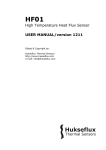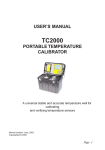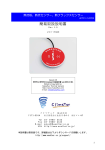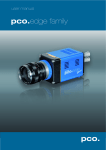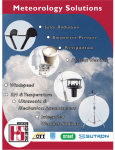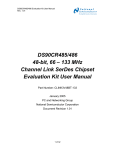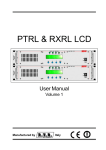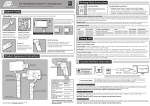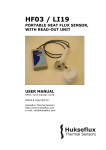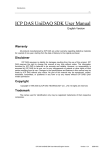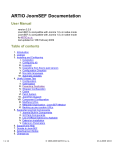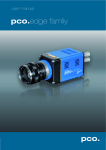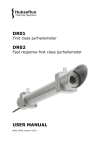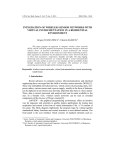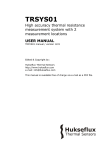Download "user manual"
Transcript
HFP01 & HFP03 Heat Flux Plate Heat Flux Sensor USER MANUAL HFP01/ HFP03 manual version 0612 Edited & Copyright by: Hukseflux Thermal Sensors http://www.hukseflux.com e-mail: [email protected] Hukseflux Thermal Sensors Contents 1 1.1 1.2 2 3 4 5 6 7 8 9 10 11 11.1 11.2 11.3 11.4 11.5 11.6 11.7 List of symbols 4 Introduction 5 General Theory 6 General heat flux sensor theory 6 Detailed description of the measurement: resistance error, contact resistance, deflection error and temperature dependence 8 Application in meteorology 11 Application in building physics 14 Specifications of HFP01 16 Short user guide 19 Putting HFP01 into operation 20 Installation of HFP01 in meteorology 21 Installation of HFP01 in building physics 22 Maintenance of HFP01 24 Electrical connection of HFP01 26 Appendices 27 Appendix on cable extension for HFP01 27 Appendix on trouble shooting 28 Appendix on heat flux sensor calibration 29 Appendix on heat transfer in meteorology 30 Appendix on heat transfer in building physics 32 Appendix on HFP03 33 CE declaration of conformity 35 HFP01/ HFP03 manual version 0612 page 2/35 Hukseflux Thermal Sensors List of symbols Heat flux Thermal conductivity of the surrounding medium or object on which the sensor is mounted Voltage output HFP01 sensitivity Thermal conductivity dependence of Esen Time Surface area Electrical resistance Thermal resistance Temperature Temperature dependence Depth of burial ϕ W m-2 λ V Esen Eλ t A Re Rth T TD d W/mK V µV/Wm-2 mK/W s m2 Ω Km2/W K %/K m Subscripts Property of the sensor Property of air Property during calibration Property of the object on which HFP01 is mounted Property at the soil surface HFP01/ HFP03 manual version 0612 sen air cal obj surf page 3/35 Hukseflux Thermal Sensors Introduction HFP01 is the world’s most popular sensor for heat flux measurement in the soil and through walls and building envelopes. By using a ceramics-plastic composite body the total thermal resistance is kept small. HFP01 serves to measure the heat that flows through the object in which it is incorporated or on which it is mounted. The actual sensor in HFP01 is a thermopile. This thermopile measures the differential temperature across the ceramics-plastic composite body of HFP01. Working completely passive, HFP01 generates a small output voltage proportional to the local heat flux. Using HFP01 is easy. For readout one only needs an accurate voltmeter that works in the millivolt range. To calculate the heat flux, the voltage must be divided by the sensitivity; a constant that is supplied with each individual instrument. HFP01 can be used for in-situ measurement of building envelope thermal resistance (R-value) and thermal transmittance (Hvalue) according to ISO 9869, ASTM C1046 and ASTM 1155 standards. Traceability of calibration is to the “guarded hot plate” of National Physical Laboratory (NPL) of the UK, according to ISO 8302 and ASTM C177. A typical measurement location is equipped with 2 sensors for good spatial averaging. If necessary two sensors can be put in series, creating a single output signal. If measuring in soil, in case a more accurate measurement is needed the model HFP01SC should be considered. In case a more sensitive measurement is required, model HFP03 should be considered. In case of special requirements, like high temperature limits, smaller size or flexibility the PU series could offer a solution. This manual can also be used for HFP03. Differences between HFP03 and HFP01 are highlighted in a special appendix on HFP03. HFP01/ HFP03 manual version 0612 page 4/35 Hukseflux Thermal Sensors Figure 1 Drawing of HFP01 sensor Figure 2 HFP01 heat flux plate dimensions: (1) sensor area, (2) guard of ceramics-plastic composite, (3) cable, standard length is 5 m. All dimensions are in mm. HFP01/ HFP03 manual version 0612 page 5/35 Hukseflux Thermal Sensors 1 General Theory 1.1 General heat flux sensor theory As in most heat flux sensors, the actual sensor in HFP01 is a thermopile. This thermopile measures the differential temperature across the ceramics-plastic composite body of HFP01. Working completely passive, it generates a small output voltage that is proportional to the differential temperature that powers the heat flux travelling through it. (heat flux is proportional to the differential temperature divided by the local thermal conductivity of the heat flux sensor). Assuming that the heat flux is steady, that the thermal conductivity of the body is constant and that the sensor has negligible influence on the thermal flow pattern, the signal of HFP01 is proportional to the local heat flux in Watt per square meter. Using HFP01 is easy. For readout one only needs an accurate voltmeter that works in the millivolt range. To convert the measured voltage Vsen to a heat flux ϕ, the voltage must be divided by the sensitivity Esen, a constant that is supplied with each individual sensor. ϕ = Vsen / Esen 1.1.1 HFP01 is a weatherproof sensor. It complies with the CE directives. HFP01/ HFP03 manual version 0612 page 6/35 Hukseflux Thermal Sensors Figure 1.1 General characteristics of a heat flux sensor like HFP01. When heat (6) is flowing through the sensor, the filling material (3) will act as a thermal resistance. Consequently the heat flow ϕ will go together with a temperature gradient across the sensor, creating a hot side (5) and a cold side (4). The majority of heat flux sensors is based on a thermopile; a number of thermocouples (1,2) connected in series. A single thermocouple will generate an output voltage that is proportional to the temperature difference between the joints (copper-constantan and constantan-copper). This temperature difference is, provided that errors are avoided, proportional to the heat flux, depending only on the thickness and the average thermal conductivity of the sensor. Using more thermocouples in series will enhance the output signal. In the picture the joints of a copper-constantan thermopile are alternatively placed on the hot- and the cold side of the sensor. The two different alloys are represented in different colours 1 and 2. The thermopile is embedded in a filling material, usually a plastic, in case of HFP01 a special Ceramicsplastic composite. Each individual sensor will have its own sensitivity, Esen, usually expressed in Volts output, Vsen, per Watt per square meter heat flux ϕ. The flux is calculated: ϕ = Vsen/ Esen. The sensitivity is determined at the manufacturer, and is found on the calibration certificate that is supplied with each sensor. HFP01/ HFP03 manual version 0612 page 7/35 Hukseflux Thermal Sensors 1.2 Detailed description of the measurement: resistance error, contact resistance, deflection error and temperature dependence As a first approximation, the heat flux is expressed as: ϕ = Vsen / Esen 1.2.1 This paragraph offers a more detailed description of the heat flux measurement. It should be noted that the following theory for correcting deflection errors and temperature dependence is not often applied. Usually one will work with formula 1.2.1, possibly corrected with 1.2.2. When mounting the sensor in or on an object with limited thermal resistance, the sensor thermal resistance itself might be significantly influencing the undisturbed heat flux. One part of the resulting error is called the resistance error, reflecting a change of the total thermal resistance of the object. Figure 1.2.1 The resistance error: a heat flux sensor (2) increases or decreases the total thermal resistance of the object on which it is mounted (1) or in which it is incorporated. This can lead either to a larger of smaller (increase of or decrease of the- ) heat flux (3). HFP01/ HFP03 manual version 0612 page 8/35 Hukseflux Thermal Sensors Figure 1.2.2 The resistance error: a heat flux sensor (2) increases or decreases the total thermal resistance of the object on which it is mounted or in which it is incorporated. An otherwise uniform flux (1) is locally disturbed (3). In this case the measured heat flux is smaller than the actual undisturbed flux,( 1). A first order correction of the measurement is: ϕ = (Rthobj+Rthsen ) V sen /E sen Rthobj 1.2.2 This correction is often applied with thin or well-isolated walls. Note: this correction can only be determined for objects with limited (finite) dimensions. For this reason this correction is not applicable in soils. In addition to the resistance error, the fact that the thermal conductivity of the surrounding medium differs from the sensor thermal conductivity causes the heat flux to deflect. The resulting error is called the deflection error. The deflection error is determined in media of different thermal conductivity by experiments or using theoretical approximations. The result of these experiments is laid down as the so-called thermal conductivity dependence Eλ. The order of magnitude of Eλ is constant for one sensor type. For HFP01, Eλ is given in the list of specifications. Esen = E sen, cal (1+Eλ (λcal - λmed)) 1.2.3 Note: this correction can only be applied when there is a substantial amount of (at least 40 mm) medium on both sides of the sensor. In soils λmed usually is not known. The value of λcal typically is zero. HFP01/ HFP03 manual version 0612 page 9/35 Hukseflux Thermal Sensors Figure 1.2.3 The deflection error. The heat flux (1) is deflected in particular at the edges of the sensor. As a result the measurement will contain an error; the so-called deflection error. The magnitude of this error depends on the medium thermal conductivity, sensor thermal properties as well as sensor design. In addition, the sensitivity of heat flux sensors is temperature dependent. The temperatre dependence TD reflects the fact that the sensitivity changes with temperature: Esen = E sen, cal (1+TD (Tcal - Tsen )) 1.2.4 Combining 1.2.3 and 1.2.4: Esen = E sen, cal {(1+Eλ (λcal - λmed))+ (1+TD (Tsen - Tcal ))} 1.2.5 This correction is rarely applied because TD is typically small. Apart from the sensor's own thermal resistance, also contact resistances between sensor and surrounding material are demanding special attention. Essentially any air gaps add to the sensor thermal resistance, at the same time increasing the deflection error in an unpredictable way. In all cases the contact between sensor and surrounding material should be as well and as stable as possible, so that it is not influencing the measurement. It should be noted that the conductivity of air is approximately 0.02 W/m.K, ten times smaller than that of the heat flux sensor. It follows that air gaps form major contact resistances, and that avoiding the occurrence of significant air gaps should be a priority whenever heat flux sensors are installed. HFP01/ HFP03 manual version 0612 page 10/35 Hukseflux Thermal Sensors 2 Application in meteorology In meteorological applications the primary purpose is to measure the part of the energy balance that goes into the soil. This soil heat flux in itself is in most cases of limited interest. However, knowing this quantity, it is possible to “close the balance". In other words, apply the law of conservation of energy to check the quality of the other (convective and evaporative) flux measurements. For more information on meteorological measurement of heat flux, see the appendix. Users should be aware of the fact that the soil heat flux measurement with HFP01 in most cases is not resulting in a high accuracy result. The main causes are: 1 the fact that measurement at one location in the soil will have only limited validity for a larger area; variability of soil surface can be very lage. 2 the fact that variations in soil thermal properties over time result in significant measurement errors. If measuring in soil, in case a more accurate measurement is needed the model HFP01SC should be considered. Figure 2.1 Typical meteorological energy balance measurement system with HFP01 installed under the soil. HFP01/ HFP03 manual version 0612 page 11/35 Hukseflux Thermal Sensors In a perfect environment, the initial calibration accuracy of heat flux sensors is estimated to be +3 /- 3%. In field experiments it is difficult to find one location that can be considered to be representative of the whole region. Also temporal effects of shading on the soil surface can give a false impression of the heat flux. For this reason typically two sensors are used for each station, usually at a distance of 5 meters. Apart from the question of representativeness of the measurement location, the main problem with heat flux measurements in meteorology is that the sensitivity of a heat flux sensor is dependent on the thermal conductivity of the surrounding medium. This deflection error is described in chapter 1. In soil heat flux measurement the accuracy of soil heat flux measurements very much suffers from the fact that the surrounding medium is both unknown to the manufacturer and changing over time. A typical HFP01 has a thermal conductivity of 0.8 W/mK, while soils can vary between extremes of 0.2 and 4 W/mK. Sand in relatively dry condition can have a thermal conductivity of 0.3 W/mK (perfectly dry 0.2) while the same sand when saturated with water reaches 2.5 W/mK. A typical HFP01 performing a correct measurement in dry sand will make a – 16% error in wet sand. As in wet sand the heat tends to travel around the badly conducting sensor, the flux will be underestimated by 16%. This example serves to illustrate that in soils where conditions vary the so-called thermal conductivity dependence leads to large deflection errors. The third important error is temperature dependence. Over the entire temperature range from -30 to + 70 degrees C, the temperature error is +/- 5%. Taking the worst case soil, pure sand, for the conventional heat flux measurement in meteorology the overall worst case accuracy is estimated to be +8 /- 24%. This is rounded off to +10 / -25 %. In most situations the soil will not be pure sand, and in an average climate the difference between the yearly extremes might be -10 + 40 degrees C and a thermal conductivity range from 0.2 to 1 W/mK. The temperature error then is +2 / -3%, the thermal conductivity accounts for +0 / - 7%, the calibration +3 / -3 %. The result of +5 / -13 % is rounded off to +5 / -15% HFP01/ HFP03 manual version 0612 page 12/35 Hukseflux Thermal Sensors Heat flux sensors in meteorological applications are typically buried at a depth of about 5 cm below the soil surface. Burial at a depth of less than 5 cm is generally not recommended. In most cases a 5 cm soil layer on top of the sensor offers just sufficient mechanical consistency to guarantee long-term stable installation conditions. Burial at a depth of more than 8 cm is generally not recommended, because time delay and amplitude become less easily traceable to surface fluxes at larger installation depths. See the appendix for more details. Summary: In case of use of HFP01 in meteorological applications, the use of 2 sensors per station is recommended. This creates redundancy and a better possiblity for judging the quality of the measurement accuracy. Typically one will work with two separately measured sensor outputs; the average value is the measurement result. In normal soils (clays, silts) the overall expected measurement accuracy for 12 hr totals is +5 / -15%. In case of pure sands the overall measurement accuracy for 12 hr totals is +10 / -25 %. The accuracy mainly is a function of the thermal conductivity of the surrounding medium. In case of soils the moisture content plays a dominant role. The wider accuracy range in sand is due to the fact that the thermal conductivity of sand varies with moisture content from roughly 0.2 (perfectly dry) to 2.5 (saturated). With other soils and walls (see chapter on building physics) the variation of thermal conductivity is much less; roughly from 0.1 to 1 W/mK. If measuring in soil, in case a more accurate measurement is needed the model HFP01SC should be considered. HFP01/ HFP03 manual version 0612 page 13/35 Hukseflux Thermal Sensors 3 Application in building physics HFP01 can be used for in-situ measurement of building envelope thermal resistance (R-value) and thermal transmittance (Hvalue) according to ISO 9869, ASTM C1046 and ASTM 1155 standards. When studying the energy balance of buildings, heat is exchanged by various mechanisms. The total result is a certain heat flux. The dominant mechanisms are usually radiative transfer by solar radiation and convective transport by flowing air. In most applications in building physics the sensor HFP01 is simply mounted on or in the object of interest (see figure 3.1). At the sensor surface, the convective heat of the air and the radiation by the sun are transformed into conductive heat. In case of incorporation into the wall, the conductive flux through the wall is directly measured. If direct beam solar radiation is present, the solar radiation is usually dominant. The maximum expected solar radiation level is about 1500 W/m2. In case of convective transport of heat by the air, the convective transport is roughly proportional to the difference in temperature between wall and air, and strongly depends on the local wind speed. See the appendix on heat transfer in building physics for more information. It is possible that the heat flux sensor contributes significantly to the total thermal resistance of the object (resistance error). In this case the heat flux measurement must be corrected. For the correction, see chapter 1. In order to limit the resistance error, in all cases the contact between sensor and surrounding material should be as well and as stable as possible, so that air gaps are not influencing the measurement. In a perfect environment, the initial calibration accuracy of heat flux sensors is estimated to be +3 /- 3%. In case of use of HFP01 on walls (insulating as well as bricks and cements) the overall expected measurement accuracy for 12 hr totals is +5 / -5 %. HFP01/ HFP03 manual version 0612 page 14/35 Hukseflux Thermal Sensors In case of analysis of thermal resistance of building envelopes, the minimum recommended measurement time is 48 hours. Hukseflux also offeres a complete measurement system for analysis of building envelopes: TRSYS. Figure 3.1 Estimation of convective, radiative and conductive heat flux in building physics. The heat flux sensor is simply mounted on or in the object of interest. This is typically in walls, but can also be in the soil, e.g. on top of an underground heat storage tank. HFP01/ HFP03 manual version 0612 page 15/35 Hukseflux Thermal Sensors 4 Specifications of HFP01 HFP01 is a heat flux sensor that measures the local heat flux perpendicular to the sensor surface in the medium in which it is incorporated or the object on which it is mounted. It can only be used in combination with a suitable measurement and control system. The HFP01 specifications except size, resistance, sensitivity and weight are also applicable to sensor type HFP03; see appendix. HFP01 GENERAL SPECIFICATIONS Specified Heat flux in W/m2 perpendicular to the measurements sensor surface Installation See the product manual for recommendations. Temperature range -30 to +70 degrees C Recommended number Meteorological: two for each of sensors measurement station. Building Physics: typically 1 or 2 sensors per measurement location depending on building and wall properties. CE requirements HFP01 complies with CE directives Series connection HFP01 sensors can be put electrically in series to create a sensor with higher sensitivity of better spatial resolution using only one single readout channel. The sensitivity then is the average of the two sensitivities. Thermal conductivity -0.07 % m.K/W (nominal value) dependence Eλ λcal = 0 Temperature < +0.1%/ °C dependence TD Table 4.1 List of HFP01 specifications. (continued on next 2 pages) HFP01/ HFP03 manual version 0612 page 16/35 Hukseflux Thermal Sensors HFP01 MEASUREMENT SPECIFICATIONS Initial calibration +3 /- 3% accuracy Overall uncertainty estimated to be within +5 /- 5%, based statement according to on a standard uncertainty multiplied by ISO a coverage factor of k = 2, providing a level of confidence of 95%. Application related errors should be added to this error. Expected typical Initial calibration accuracy: accuracy (12 hr totals) +3 /- 3% of heat flux Added errors within most common soils, measurement in soil (clays, silts, organic), on most walls @ 20 degrees C: +0 / - 7% Added typical temperature error: -10 + 40 degrees C +2 / - 3% Total typical value in soil (rounded off): within +5 / -15 % Expected worst case Initial calibration accuracy: accuracy (12 hr totals) +3 /- 3% of heat flux Added errors with worst case soil, pure measurement in soil sand @ 20 degrees C: +0 / - 16% Added worst case temperature error: -30 + 70 degrees C +5 / - 5% Total worst case value in soil (rounded off): within +10 / -25 % Expected typical Initial calibration accuracy: accuracy (12 hr totals) +3 /- 3% of heat flux Added typical temperature error: -10 + measurement on a wall 40 degrees C +2 / - 3% Total typical value on a wall (insulating, brick, cement) (rounded off): within +5 / -5 % Low thermal resistance walls require correction for the resistance error. Table 4.1 List of HFP01 specifications. (started on previous page, continued on next page) HFP01/ HFP03 manual version 0612 page 17/35 Hukseflux Thermal Sensors HFP01 SENSOR SPECIFICATIONS Esen (nominal) 50 µV/ W. m-2 (exact value on calibration certificate) λcal = 0, Tcal =20 °C Sensor thermal 0.8 W/mK conductivity < 6.25 10 -3 Km2/W Sensor thermal resistance Rth Response time ± 3 min (equals average soil) (nominal) Range + 2000 to - 2000 W.m-2 Non stability < 1% change per year (normal meteorological / building physics use) Required readout 1 differential voltage channel or possibly (less ideal) 1 single ended voltage channel. When using more than one sensor and having a lack of input channels, it can be considered to put several sensors in series, while working with the average sensitivity. Expected voltage Meteorology: -10 to - + 20 mV output Building physics: -10 to 75 mV (exposed to solar radiation) Power required Zero (passive sensor) Resistance 2 Ohm (nominal) plus cable resistance Required programming ϕ = Vsen/ Esen Sensor dimensions 80 mm diameter, 5 mm thickness Cable length, diameter 5 meters, 5 mm Weight including 5 m 0.2 kg cable, transport dim. transport dimensions 32x23x3 cm CALIBRATION Calibration traceability to the “guarded hot plate” of National Physical Laboratory (NPL) of the UK. Applicable standards are ISO 8302 and ASTM C177. Recalibration interval Dependent on application, if possible every 2 years, see appendix OPTIONS Extended cable Additional cable length x metres (add to 5m), AC100 amplifier, LI 18 hand held readout, extended temperature range Table 4.1 List of HFP01 specifications. (started on previous 2 pages) HFP01/ HFP03 manual version 0612 page 18/35 Hukseflux Thermal Sensors 5 Short user guide Preferably one should read the introduction and first chapters to get familiarised with the heat flux measurement and the related error sources. The sensor should be installed following the directions of the next paragraphs. Essentially this requires a data logger and control system capable of readout of voltages, and capability to perform division of the measurement by the sensitivity. The first step that is described in paragraph 6 is and indoor test. The purpose of this test is to see if the sensor works. The second step is to make a final system set-up. This is strongly application dependent, but it usually involves permanent installation of the sensor and connection to the measurement system. Directions for this can be found in paragraphs 7 to 11. HFP01/ HFP03 manual version 0612 page 19/35 Hukseflux Thermal Sensors 6 Putting HFP01 into operation It is recommended to test the sensor functionality by checking the impedance of the sensor, and by checking if the sensor works, according to the following table: (estimated time needed: 5 minutes) The typical impedance of the wiring is 0.1 ohm/m. Typical impedance should be 1.5 ohm for the total resistance of two wires (back and Check the impedance of the sensor. forth) of each 5 meters, plus the typical sensor Use a multimeter at the 10 ohms impedance of 2 ohms. range. Measure at the sensor output Infinite indicates a first with one polarity, than reverse broken circuit; zero polarity. Take the average value. indicates a short circuit. Check if the sensor reacts to heat flux. The thermopile should Use a multimeter at the millivolt react by generating a range. Measure at the sensor output. millivolt output signal. Generate a signal by touching the thermopile hot joints (red side) with your hand. Table 6.1 Checking the functionality of the sensor. The procedure offers a simple test to get a better feeling how HFP01 works, and a check if the sensor is OK. Warning: during this part of the test, please put the sensor in a thermally quiet surrounding because a sensor that generates a significant signal will disturb the measurement. The programming of data loggers is the responsibility of the user. Please contact the supplier to see if directions for use with your system are available. HFP01/ HFP03 manual version 0612 page 20/35 Hukseflux Thermal Sensors 7 Installation of HFP01 in meteorology HFP01 is generally installed at the location where one wants to measure at least 4 cm depth below the surface. A typical depth of installation is 5 cm. Typically 2 sensors are used per measurement location in order to promote spatial averaging, and to have some redundancy for improved quality assurance. Sensors are typically several meters apart. The more even the surface on which HFP01 is placed the better. When covering HFP01 with soil, it should be done such that the soil below and on top is the same. If possible, it is safest to install HFP01 from the side. Care should be taken to prevent the creation of air gaps between sensor and soil. In meteorological applications, permanent installation is preferred. It is recommended to fix the location of the sensor by attaching a metal pin to the cable. Attachment of the pin to the cable can be done using a tie-wrap. HFP01 sensors can be put electrically in series to create a sensor with higher sensitivity of better spatial resolution using only one single readout channel. Sensitivity is the average of the two sensitivities. Table 7.1 General recommendations for installation of HFP01. In case of exceptional applications, please contact Hukseflux. HFP01/ HFP03 manual version 0612 page 21/35 Hukseflux Thermal Sensors 8 Installation of HFP01 in building physics HFP01 is generally installed on the surface of a wall, or alternatively it is integrated into the wall. Typically 2 sensors are used per measurement location in order to promote spatial averaging, and to have some redundancy for improved quality assurance. Sensors are typically several meters apart. Location with exposure to direct solar radiation should be avoided as much as possible. In the northern hemisphere, north-facing walls are preferred. Typically locations exposed to solar radiation are avoided, in particular when thermal resistance or H-value measurements of a building component are made. When installing on the wall surface, in case of exposure to strong radiation (for instance direct beam solar radiation), the spectral properties of the sensor surface must be adapted to match those of the wall. This can be done by covering the sensor with paint or sheet material of the same colour. The more heat flux, the better; strongly cooled or strongly heated rooms are ideal measurement locations. It can be considered to temporarily activate heaters or air conditioning for a perfect measurement. The least ideal is a situation in which the heat flux is constantly changing direction. This often goes together with relatively small fluxes and strong effects of “loading” For detailed analysis of one building element it can be beneficial to install one heat flux sensor on one side, and the other on the other side. Measuring in such a way will allow seeing the thermal response time of a system in more detail. The location of installation preferably should be a large wall section which is relatively homogeneous. Areas with local thermal bridges should be avoided. The more even the surface on which HFP01 is placed the better. The optimal configuration is the heater in the same plane as the surrounding surface of the object. Table 8.1 General recommendations for installation of HFP01 in application in building physics. In case of exceptional applications, please contact Hukseflux. (continued on next page) HFP01/ HFP03 manual version 0612 page 22/35 Hukseflux Thermal Sensors Any air gaps should be filled as much as possible. Permanent installation is preferred. It is recommended to fix the location of the sensor by gluing with silicone glue. Alternatively for short-term installation either toothpaste (1-2 days) or “DOW CORNING heat sink compound 340” can be used. Typically temporary installation is fixed using tape across the guard. The tape should be as far as possible to the edge. Independent attachment of the cable can be done to an object that can resist strain in case of accidental force. HFP01 sensors can be put electrically in series to create a sensor with higher sensitivity of better spatial resolution using only one single readout channel. Table 8.1 General recommendations for installation of HFP01 in application in building physics. In case of exceptional applications, please contact Hukseflux. (started previous page) HFP01/ HFP03 manual version 0612 page 23/35 Hukseflux Thermal Sensors 9 Maintenance of HFP01 Once installed, HFP01 is essentially maintenance free. Usually errors in functionality will appear as unreasonably large or small measured values. In case 2 sensors are mounted on one location the ratio of measurement resuls could be monitored over time; this will give a clue if there is any unstability. Typicaly long term comparison of 2 sensors can serve as an alternative for re-calibration at the factory. As a general rule, this means that a critical review of the measured data is the best form of maintenance. At regular intervals the quality of the cables can be checked. Theoretically, it is a possibiliy to send sensors back to the factory for re-caliration; The reality os that in mist applications this is not possible. Recalibration of HFP01 often is not possible, in particular if sensors are dug in or permanently glued to a surface. If the intercomparison between 2 sensor on one location is judged to be insufficient, use of model HFP01SC self-calibrating heat flux sensor could be considered. In case of use in building physics, re-calibration can be done in the field by monting a second “reference” HFP01 on top of the “field” sensor, and by measuring the ratio of the outputs over a longer time. By measuring 10 minute averages, one can create a correlation. HFP01/ HFP03 manual version 0612 page 24/35 Hukseflux Thermal Sensors Requirements for data acquisition / amplification Capability to measure microvolt signals Preferably: 5 microvolt accuracy Minimum requirement: 50 microvolt accuracy (both across the entire expected temperature range of the acquisition / amplification equipment) In case of low amplifier accuracy it should be considered either to put two sensors in series, to purchase a pre-amplifier or to use model HFP03. Capability for the data logger To store data, and to perform or the software division by the sensitivity to calculate the heat flux. Table 9.1 Requirements for data acquisition and amplification equipment. HFP01/ HFP03 manual version 0612 page 25/35 Hukseflux Thermal Sensors 10 Electrical connection of HFP01 In order to operate, HFP01 should be connected to a measurement and system as described above. A typical connection is shown in table 11.1. HFP01 is a passive sensor that does not need any power. Cables generally act as a source of distortion, by picking up capacitive noise. It is a general recommendation to keep the distance between data logger or amplifier and sensor as short as possible. For cable extension, see the appendix on this subject. Wire Colour Sensor output + Sensor output - White Green Wire Colour Sensor 1 output + White Measurement system Voltage input + Voltage input – or (Analogue) ground Shield (Analogue) ground or Voltage input Table 10.1 The electrical connection of HFP01. The heat flux plate output usually is connected to a differential voltage input. Measurement system To sensor 2 output Sensor 1 output Green Voltage input – or (Analogue) ground Sensor 2 output + White Voltage input + Sensor 2 output Green To sensor 1 output + Shield (Analogue) ground or Voltage input Table 10.2 The electrical connection of two sensors HFP01 in series. When using more than one sensor and having a lack of input channels, it can be considered to put several sensors in series, while working with the average sensitivity. HFP01/ HFP03 manual version 0612 page 26/35 Hukseflux Thermal Sensors 11 Appendices 11.1 Appendix on cable extension for HFP01 HFP01 is equipped with one cable. It is a general recommendation to keep the distance between data logger or amplifier and sensor as short as possible. Cables generally act as a source of distortion, by picking up capacitive noise. HFP01 cable can however be extended without any problem to 100 meters. If done properly, the sensor signal, although small, will not significantly degrade because the sensor impedance is very low. Cable and connection specifications are summarised below. Cable 2-wire shielded, copper core (at Hukseflux we use 3 wire shielded, of which we only use 2 per cable) 0.1 Ω/m or lower Core resistance Outer (preferred) 5 mm diameter Outer sheet (preferred) polyurethane (for good stability in outdoor applications). Connection Either solder the new cable core and shield to the original sensor cable, and make a waterproof connection using cable shrink, or use gold plated waterproof connectors. Preferably the shield should also be extended. Table 11.1.1 Specifications for cable extension of HFP01. HFP01/ HFP03 manual version 0612 page 27/35 Hukseflux Thermal Sensors 11.2 Appendix on trouble shooting This paragraph contains information that can be used to make a diagnosis whenever the sensor does not function. 1 Measure the impedance across the sensor The sensor does not give wires. any signal This check can be done even when the sensor is buried. The resistance should be around 2 ohms (sensor resistance) plus cable resistance (typically 0.1 ohm/m). If it is closer to zero there is a short circuit (check the wiring). If it is infinite, there is a broken contact (check the wiring). 2 Check if the sensor reacts to an enforced heat flux. In order enforce a flux, it is suggested to mount the sensor on a piece of metal, create a thermal connection with some thermal paste, that is used in electronics (if not available toothpaste will also do), and to use a lamp as a thermal source. A 100 Watt lamp mounted at 10 cm distance should give a definite reaction. 3 Check the data acquisition by applying a mV source to it in the 1 mV range. The sensor 1 Check if the right calibration factor is entered signal is un- into the algorithm. Please note that each sensor realistically has its own individual calibration factor. high or low. 2 Check if the voltage reading is divided by the calibration factor by review of the algorithm. 3 Check if the mounting of the sensor still is in good order. 4 Check the condition of the leads at the logger. 5 Check the cabling condition looking for cable breaks. 6 Check the range of the data logger; heat flux can be negative (this could be out of range) or the amplitude could be out of range. 7 Check the data acquisition by applying a mV source to it in the 1 mV range. The sensor 1 Check the presence of strong sources of signal shows electromagnetic radiation (radar, radio etc.) unexpected 2 Check the condition of the shielding. variations 3 Check the condition of the sensor cable. Table 11.2.1 Trouble shooting for HFP01. HFP01/ HFP03 manual version 0612 page 28/35 Hukseflux Thermal Sensors 11.3 Appendix on heat flux sensor calibration The sensitivity Esen of a Heat Flux Sensor is defined as the output Vsen for each Watt per square meter heat flowing through it, in a stationary transversal heat flow. The method that is generally applied during production is described below. Figure 12.3.1 The calibration method for HFP01; a heat flux sensor (2) is calibrated by mounting it on a metal heat sink (1) with a constant temperature. A film heater (3) is used to generate a well known heat flux. If the thermal conductivity of the sensor is 0.8 W/m.K, at a heat flux of 300 W/m2, and a sensor thickness is 5 mm, the temperature raise at the heater is 2 degrees. For an un-insulated sensor, this would result in an error of about 20 W/m2 because of radiative and convective losses. For this reason the heater is again insulated, using foam insulating material. Now 99% of the heat flux passes through the sensor. As a result the accuracy is about 1%. The method has to be validated for application by comparison to a reference calibration as described above. The heater calibration is traceable to the “guarded hot plate” of National Physical Laboratory (NPL) of the UK. Applicable standards are ISO 8302 and ASTM C177. The calibration reference conditions for HFP01 calibration at Hukseflux are: Temperature: 20 °C Medium thermal conductivity: 0 W/mK Heat Flux: 300 W/m2 HFP01/ HFP03 manual version 0612 page 29/35 Hukseflux Thermal Sensors 11.4 Appendix on heat transfer in meteorology Note: All units used in this appendix are clarified in the text. Not all units in this appendix are mentioned in the list of symbols. Heat is transferred by radiation, convection and conduction. In most meteorological experiments, the main source of heat during the daytime is the solar radiation. The maximum power of the sun on a horizontal surface is about 1500 W/m2 in case of a bright sun at noon. The solar radiation is absorbed by the soil, and the resulting heat is used for evaporation of water, heating the air and heating the soil. At night, when the sun is no longer there, again radiation plays a role; this time the dominant energy flow is from the soil, emitting far infra-red radiation to the sky. The maximum power is about (minus) -150 W/m2, in case of a clear blue sky. Other sources than the radiation are usually negligible. The resulting energy flows through the soil at 5 cm are usually between -100 and +300 W/m2. For various practical and theoretical reasons, the heat flux plate cannot be installed directly at the surface. The main reason is that it would distort the flow of moisture, and be no longer representative of the surrounding soil, both from a moisture- and from a thermal/spectral point of view. Also in case of installation close to the surface, the sensor would be more vulnerable and the stability of the installation becomes an uncertain factor. For these reasons the flux at the soil surface ϕsurf is typically estimated from the flux measured by the heat flux sensor, ϕsen, plus the change of energy that is stored in the layer above it over a certain time, S. ϕsurf = ϕsen + S 11.4.1 The parameter S is called the storage term. The storage term is calculated using an averaged soil temperature measurement combined with an estimate of the volumetric heat capacity of the volume above the sensor. HFP01/ HFP03 manual version 0612 page 30/35 Hukseflux Thermal Sensors S = (T1-T2). Cv.d / (t1-t2) 11.4.2 Where S is the storage term, T1-T2 is the temperature change in the measurement interval, Cv the volumetric heat capacity, d the depth of installation of the soil heat flux sensors, t1-t2 the length of the measurement interval. At an installation depth of 4 cm, the storage term typically represents up to 50% of the total flux ϕsurf . When the temperature is measured closely below the surface, the response time of the storage term measurement to a changing ϕsurf is in the order of magnitude of 20 minutes, while the heat flux sensor ϕsen (buried at twice the depth) is a factor 4 slower (square of the depth). This implies that a correct measurement of the storage term is essential to a correct measurement of ϕsurf with a high time resolution. Usually the volumetric heat capacity, Cv, is estimated from the heat capacity of dry soil, Cd, the bulk density of the dry soil r d, the water content (on mass basis), q m, and Cw, the heat capacity of water. Cv = r d (C d +q m Cw ) 11.4.3 The heat capacity of water is known, but the other parameters of the equation are much more difficult to determine, and are dependent on location and time. For determining bulk density and heat capacity one has to take local samples and to perform careful analysis. The soil moisture content measurement is difficult and suffers from various errors, so that the estimation of the storage term often is the main source off error in the soil energy balance measurement. HFP01/ HFP03 manual version 0612 page 31/35 Hukseflux Thermal Sensors 11.5 Appendix on heat transfer in building physics Note: All units used in this appendix are clarified in the text. Not all units in this appendix are mentioned in the list of symbols. Heat is transferred by radiation, convection and conduction. In most studies of buildings, the main sources of heat during the daytime are the solar radiation and the convective transfer from the outside air to the walls. During the night only convection remains. The maximum power of the sun on a horizontal surface is about 1500 W/m2 in case of a bright sun at noon. The solar radiation on a non horizontal wall is mainly determined by the direct beam (contrary to the diffuse) solar radiation. The direct beam solar radiation is extremely variable in both intensity and direction during the day. The convective transport of heat from the wall to the air, ϕair, is a function of the heat transfer coefficient, Ctr, and the temperature difference between air and sensor, Tair - Tsen. ϕair = Ctr ( Tair - Tsen ) 11.5.1 In buildings, under indoor conditions we can expect wind speeds of 1 m/s. Working environments will 90% of the cases have wind speeds below 0.5 m/s. Under outdoor conditions up to 30 m/s can be considered normal, with 90% of the cases below 15m/s. A reasonable approximation of the heat transfer coefficient at moderate wind speeds is given by: Ctr = 5 + 4 Vwind 11.5.2 With Ctr in W/m2K and in Vwind m/s. HFP01/ HFP03 manual version 0612 page 32/35 Hukseflux Thermal Sensors 11.6 Appendix on HFP03 HFP03 is an ultra sensitive sensor for heatflux measurement of small heat fluxes through soil, walls and building envelopes. HFP03 has been built specifically for applications where one needs to detect small flux levels, in the order of less than 10 W/m2. Differences are HFP01 50 µV/ W.m-2 80 mm 2Ω 0.2 kg HFP03 500 µV/ W.m-2 172 mm 18 Ω 0.8 kg Sensitivity Diameter Resistance Weight including 5 m cable Table 11.6.1 Differences between HFP01 and HFP03 HFP01/ HFP03 manual version 0612 page 33/35 Hukseflux Thermal Sensors Figure 11.6.1 HFP03 heat flux plate dimensions: (1) sensor area, (2) guard of ceramics-plastic composite, (3) cable, standard length 5 m. All dimensions are in mm. HFP01/ HFP03 manual version 0612 page 34/35 Hukseflux Thermal Sensors 11.7 CE declaration of conformity According to EC guidelines 89/336/EEC, 73/23/EEC and 93/68/EEC We: Hukseflux Thermal Sensors Declare that the products: HFP01 and HFP03 Is in conformity with the following standards: Emissions: Radiated: Conducted: EN 55022: 1987 Class A EN 55022: 1987 Class B Immunity: ESD IEC 801-2; RF IEC 808-3; EFT IEC 801-4; 1984 8kV air discharge 1984 3 V/m, 27-500 MHz 1988 1 kV mains, 500V other Delft, January 2006 HFP01/ HFP03 manual version 0612 page 35/35



































